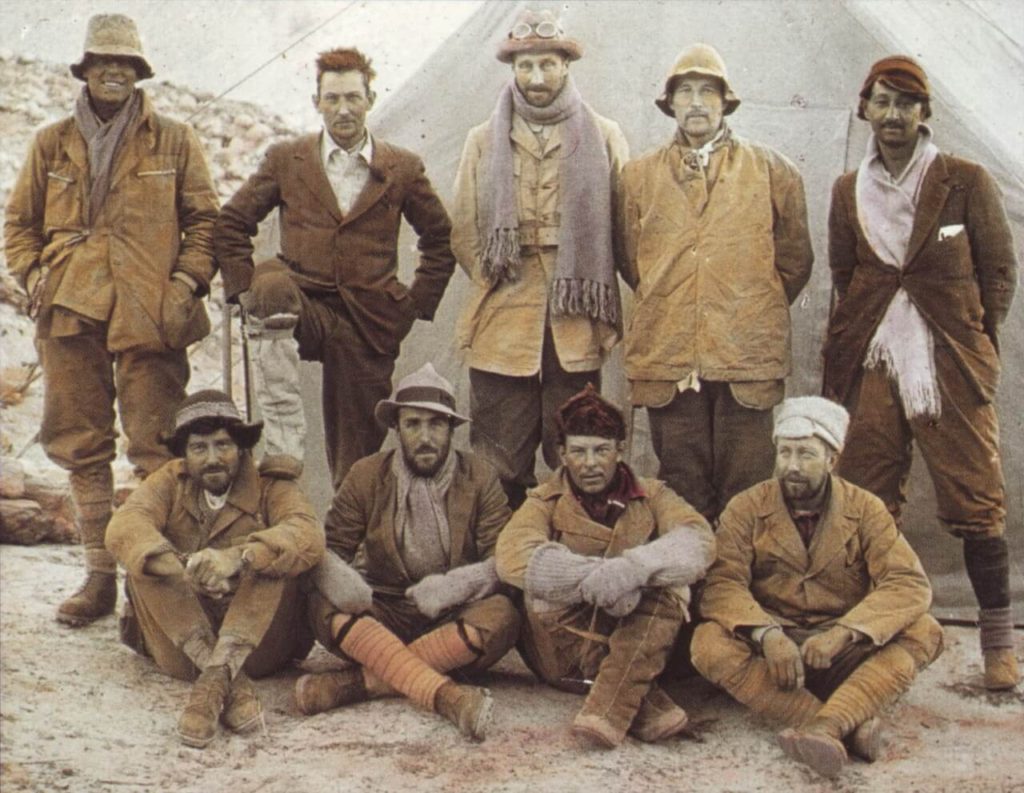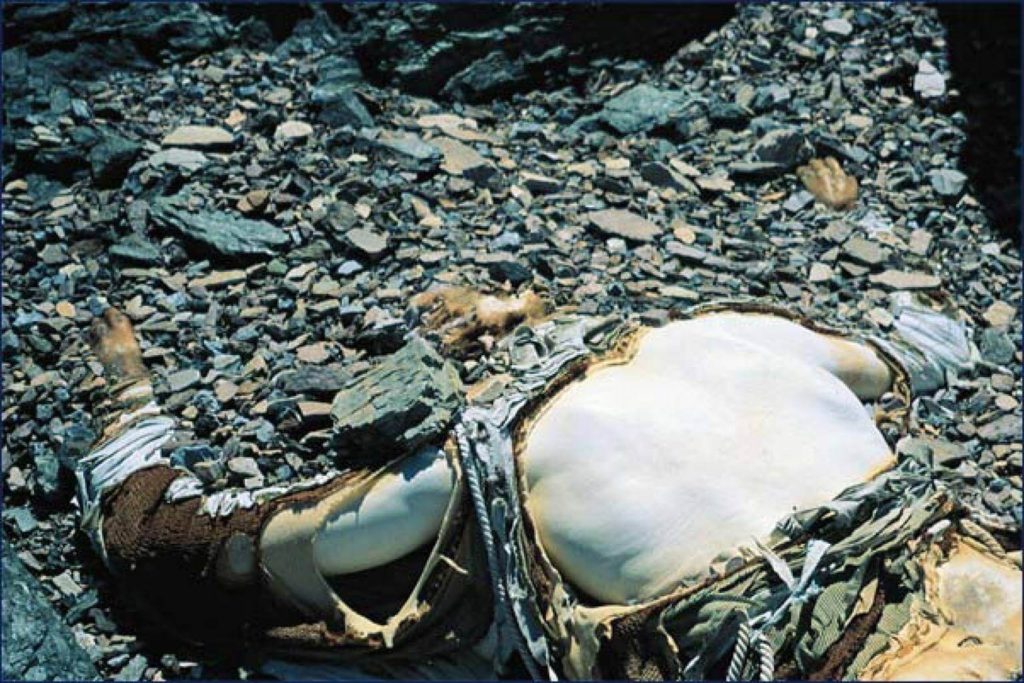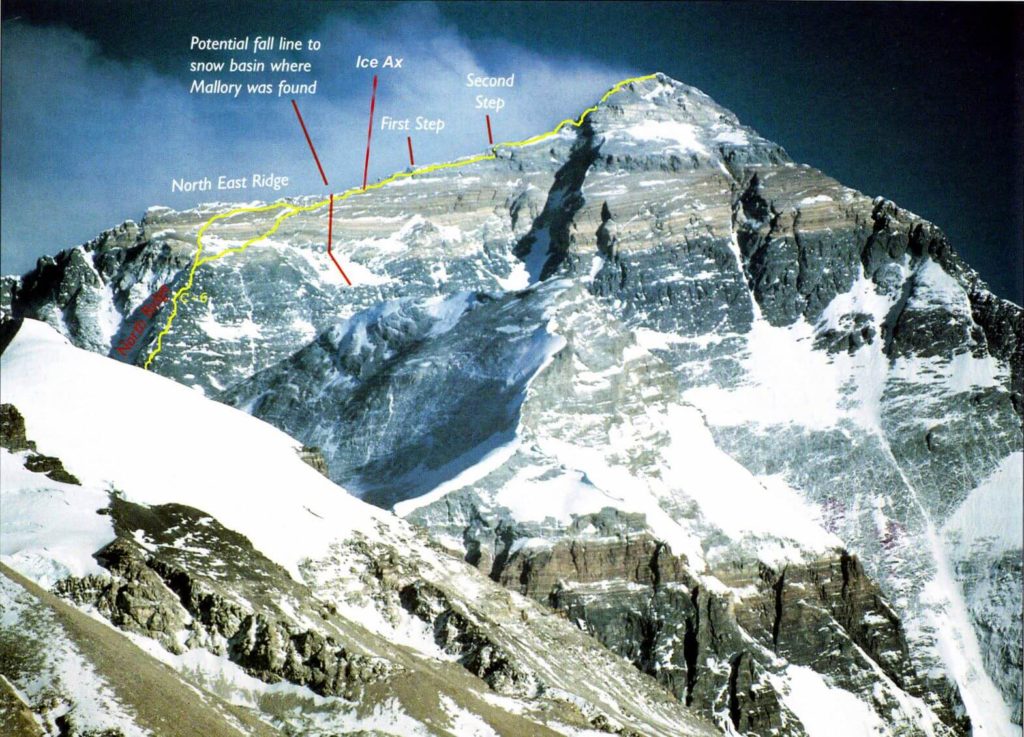The archaeology of snow and ice does not get any more extreme than on Mount Everest. High altitude, thin air, strong winds, constant cold and a 2000 m drop on one side of the survey area – this is glacial archaeology on steroids. The reward could be solving the greatest mountaineering mystery of all.

The history of the attempts to climb the highest mountain on Earth begins with three British attempts in 1921, 1922 and 1924, on the north side of the mountain. The first Everest climbers left behind a treasure trove of artefacts from their expeditions on the steep hillsides above 8000 meters – tents, oxygen bottles, food and other equipment. They also left behind what is perhaps the most intriguing mountaineering mystery of all: The fate of Mallory and Irvine, who went missing during a summit attempt on June 8th 1924. They were last seen on the upper ridge just 250 m below the summit and “going strong for the top”. Then clouds obscured the view, and they disappeared into history. Did they make it all the way to the top? And why did they disappear? The lack of information, other that they were missing, led to a lot of conjecture about the fate of the two British climbers.

The Evidence Starts to Appear
In 1933, a British expedition recovered Andrew Irvine’s ice axe at 8,450 metres, just below the ridge and before the First Step (of three rock steps before the summit pyramid). This was the first piece of solid evidence of that fateful day. Some interpreted the ice axe as having been lost when Mallory and Irvine fell to their deaths. Others were not so sure. The axe lay as if it had been left there intentionally, not dropped. The topography also indicated that the find spot was an unlikely place for a fatal fall.

Then information came forward that a Chinese climber had observed a body of an “English Dead” at 8,200 metres in 1975, close to the Chinese highest camp. The Chinese climber described his find to a Japanese climber when he was back on the mountain in 1979. The next day the Chinese climber died in an avalanche, so the story could not be confirmed. If the information was correct, it had to be either Mallory or Irvine, as no other British climbers were missing on this part of Everest at the time.
In 1986, an American expedition tried to search for Mallory and Irvine. However, adverse weather conditions and a fatal accident stopped the expedition from even getting to the search area. An old oxygen cylinder, suspected (and later proved) to be from the 1924 summit attempt, was observed in 1991, not far from the location of the ice axe.
The Mallory and Irvine Research Expedition in 1999
The last sighting in 1924, the ice axe, the oxygen cylinder, and the possible sighting of a body were the facts that all theories on Mallory and Irvine had to rely on in the 1990ies. At the time it was generally believed that Mallory and Irvine could not have reached the summit as they were too low on the ridge when observed for the last time. However, on what part of the ridge they were sighted remained a topic for discussion. In addition, it was believed that the Second Step would have been too difficult for them to climb. The only way to prove without a doubt that they did summit, would be to find a photo of the summit in one of the cameras that Mallory and Irvine were known to have carried.
The 1999 Mallory & Irvine Research Expedition set out to locate the “English dead”, sighted in 1975. This sighting was beneath the ice axe found on the ridge, so the body was believed to be that of Irvine. Maybe the camera could be found in one of his pockets? Conditions for a survey on Everest were particularly favourable in 1999. The North Face is often covered in snow, which would have made a search for a body nearly impossible. However, in 1999 strong winds had carried of the snow, exposing the rock and gravel of the north face.
When the expedition members reached the search area, they spread out and walked across the steep mountain side. There were a number of bodies from fallen climbers in the search area, but the high-tech clothing proved that they were recent victims of Everest. Then one of the mountaineers started waving frantically. He had discovered an old body. The body was lying face-down in the slope, hands outstretched upwards as if he had tried to stop his fall. The winds had torn the clothing off the back of the body. When they separated the layers of clothing at the back of the neck, a name tag appeared. It was George Mallory.

The team photographed the body, then searched through the pockets of the dead climber. The search brought forward a number of small items, such as a broken altimeter, snow goggles, a pencil, letters and papers, but no camera. They also collected samples of the clothing and a DNA-sample. Afterwards they covered the body with rocks to protect it from birds. Two men from the team came back later with a metal detector to make absolutely sure that they had not missed the camera. This search resulted in the discovery of a broken wrist-watch, but still no camera. Another object that could not be found was a picture of Mallory’s wife that he had promised to place on the summit.
The documentary of the 1999 Mallory and Irvine Research Expedition.
The Mallory and Irvine Research Expedition in 2001
The discovery of George Mallory’s body created great interest, both in the find itself and in the mystery surrounding the summit attempt in 1924. Even with the discovery of the body, without the camera there was still no conclusive evidence that could tell whether they had made it to the top or not. The fact that the snow goggles were found in Mallory’s pocket made it likely that they were descending after dark. There was also the question of the location of Irvine’s body, and whether he could have had the camera in one of his pockets. The location and position of Mallory’s body did not fit the 1975 description of the “English dead” well either. The body sighted in 1975 was said to have been lying on its back, and appeared to have been closer to the campsites than where Mallory’s body was located.

The team behind the 1999 Mallory and Irvine Research Expedition made another attempt to solve the mystery in 2001. The area where Mallory was found was surveyed in more detail than two years earlier, but without result. However, there was more snow in 2001 than in 1999, so the survey conditions were poorer, even though the team put in a lot of effort in the search area. The 2001 expedition also located the campsites from the 1922, 1924 and later expeditions. This provided important contexts for observations made by these expeditions. It also showed that Mallory was only 300 metres from their own camp, when he died. In addition, new information came forward of a 1960 sighting of another body higher up on the slope, than where Mallory had been found. It also led to the recovery of important artefacts from the early expeditions, including a woollen mitten probably belonging to Mallory or Irvine on the North-East Ridge at 8440 metres.
Since then, there has been a number of attempts to find Irvine’s body, but with no result.
Some Thoughts from the Perspective of a Glacial Archaeologist
The guys on Everest are climbers, not archaeologists. Looking at their work through the eyes of a glacial archaeologist can shed some light on the challenges of the fieldwork and how we can interpret the results.
The reason Mallory was found was not luck, but thorough investigation of the available evidence, which narrowed down the search area to 500 x 300 metres. Survey conditions in 1999 were very favourable, with little snow. Even though the team of five were not surveying systematically, they spread out over the survey area in a semi-systematic way. Conrad Anker was zigzagging his survey line when he found the body. This increased the area coverage. It is interesting to note that Anker states in “The Wildest Dream”, that he was looking back when he saw the body. This implies that he had actually passed the body, and only discovered it because he stopped to look over the terrain around him. “Stop-and-look-around” is also a recommended technique during glacial archaeology fieldwork, as the stony terrain may hide objects from certain angles.
The body is a large “object” and therefore possible to find even with a very coarse survey. The camera or other smaller objects are a completely different story. That would necessitate a very intensive survey, like we undertake during regular glacial archaeology fieldwork. This is probably not possible in the Death Zone. Smaller objects could also be buried by the rock debris coming down the steep slope, as shown by Mallory’s left arm. The 2001 survey was more thorough, but still not systematic in the sense that all areas were covered, and with the same survey intensity. Still, missing the body of Irvine, if it was lying exposed in the survey area, appears unlikely.
Artefacts found during glacial archaeological fieldwork are often not lying in their original position. They may have been moved by meltwater, wind or later visitors to the site. Meltwater is not an issue above 8,000 metres, but wind and later climbers are. We can be very certain that the body of Mallory is still resting where he died. The ice axe and the oxygen bottle are not likely to have been moved by wind due to their weight and were probably found very close to their original position, although it is possible that the bottle may have been moved a little by later climbers.
The mitten found on the Northeast Ridge is a different story. This is a light object which could easily have been moved by the strong winds. In one sense, it is a miracle that it did not blow away and was lost. It has been argued that one of the climbers may have taken off the mitten due to hypothermia (see Death in the High Mountains for an explanation of this counterintuitive behaviour). This would likely have happened on the way back to the camp, and would put at least one of the climbers very high on the Northeast Ridge during the descent. However, there is no way Mallory could have fallen all the way from the Northeast Ridge to where his body was found, without much heavier injuries than he had sustained. Maybe Mallory and Irvine were lower when the fall happened and the mitten was moved by the wind? Or they had already separated, for reasons unknown?
Another problem is the snow cover, and this is where the practicalities of arranging search expeditions on Everest crashes with reality on the ground. When we plan surveys for glacial archaeology, we have several different plans for the field season, depending on snow conditions. Surveys may be abandoned or scaled back due to snow, or moved to other areas with less snow. We also experience snowfall during fieldwork, which may pause or even end fieldwork. And here we are at the crux: the uncertainty associated with the snow conditions makes it hard to combine with commercial filming. We are regularly contacted by film companies, who are very keen to join our fieldwork. When we mention the uncertainty associated with snow conditions, it quickly becomes clear that this is a major drawback. They need to be certain that fieldwork will take place, otherwise it is too much of a gamble for them. That is fine by us – we have government funding and do not need the money from the film companies. If there is snow, there is snow. We can always survey the next year. This is completely different on Everest. The funding of the expeditions rely on money from commercial film companies. In addition, you need permissions and top-qualified sherpas to climb Everest. So you cannot wait until conditions look right and then go. Snow conditions wary quickly as well. The risk of going to Everest just to see the survey area buried in snow is very real, as several research expeditions have experienced.

Jochen Hemmleb – the Everest Historian
One of the key members of the 1999 and 2001 Everest research expeditions was Jochen Hemmleb. He undertook much of the historical research, and is in my view the foremost expert on the Mallory and Irvine mystery today. He is a writer, consultant and lecturer in mountaineering history. I met Hemmleb at the Frozen Pasts conference in Innsbruck in 2016, and got a chance to talk to him about the fieldwork on Everest, and the possibilities for a final solution to the Mallory and Irvine mystery. He is a friendly and dedicated man with a great passion for the early history of mountaineering on Everest. As I had read the two books on the expeditions in 1999 and 2001 with great interest (and multiple times), we had a quite a detailed discussion of the location of the artefacts, and the possibilities for finally solving the mystery. He also filled me in on new evidence that had appeared and the re-interpretation of old evidence. Many of the topics we covered can be found in his “Stand der Forschung” on his website. Chances are that the mystery can be solved, but this would necessitate further surveys on the Northeast Ridge. The targets for this fieldwork would be trying to find the body of Andrew Irvine high up on the ridge, locating one of the climbers’ cameras, and searching the plateau between the Second and Third Steps.
The quest to solve the Mallory and Irvine mystery is ongoing, even after locating Mallory’s body and recovering artefacts from their summit attempt. The answer may still be up there, hiding in the snow or concealed between the rocks. Will it ever be found?
Sources: Ghosts of Everest, Detectives on Everest, Tatort Mount Everest, Into the Silence
